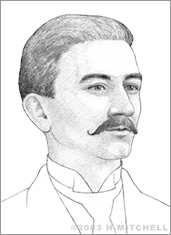Herbert Dow
Herbert Henry Dow’s name is synonymous with chemical research due to the global success of the company he founded in 1895, the Dow Chemical Company. Born in Ontario, Canada on February 26, 1866, Dow studied chemistry at Case School of Applied Science (now Case Western Reserve University), where he received a BS degree in 1888. While working on a thesis project there, he was analyzing brine samples in sites around the country when he discovered that at some sites, particularly those located near oil wells in the Midland, Michigan area, the brine contained high concentrations of bromine, a chemical used primarily in medicines and photographic chemicals at the time.
Dow researched the ways that bromine was extracted from brine and found existing procedures inefficient and expensive. The liquid would be evaporated, then the sodium chloride that crystallized would be removed, and an oxidizing agent would be added to the remaining liquid. Finally, the bromine would be distilled. The biggest drawback to this process was that it required costly fuel such as lumber for the evaporation step, and it also meant that other useful substances in the brine would be discarded.
Dow’s method was to oxidize the brine first, so that the bromine was formed in the brine. Then burlap was dipped in the brine, and a current of air would be passed through the material to carry bromine off in gas form. Next, the air would be mixed with an iron or alkali solution, and the bromine would be extracted from the air as alkali bromines.
Dow earned his first patent for this process in 1889. In 1890, he formed the Midland Chemical Corp., where he continued to refine his bromine extraction process, producing an electrolytic method that came to be known as the Dow process. Next, Dow modified his technology to diversify into chlorine chemicals, magnesium metal, and some organic chemicals. He was able to make a large variety of profitable products from the substances naturally found in Midland’s brine, including iodine, sodium compounds, and calcium. He supplied consumer products as well, including Epsom salt. In 1895, he reorganized his business into the Dow Process Company. In 1897, the company officially became The Dow Chemical Company, where Dow would serve as president and general manager until the end of his life.
After World War I, Dow invested in research into the automotive industry, creating a Metallurgical Laboratory named Dowmetal. The division produced pistons and other parts for many types of vehicles, working mainly with lightweight magnesium metal. Dow also worked with General Motors in order to produce a new type of gasoline. The result was a fuel additive called tetraethyl, which was rich in bromine. Since production of this substance would require enormous amounts of bromine, Dow knew that he needed to turn to the ocean as a source.
After earning more than 100 patents and numerous awards and honors, including the 1930 Perkin-Elmer award and induction into the National Inventors Hall of Fame, Dow died on October 16, 1930. His son, Willard H. Dow, subsequently took over the Dow Chemical Company and completed the project of extracting bromine from seawater. The first plant built to extract bromine from ocean water opened in North Carolina in 1934. Today, the Dow Chemical Company is the fifth largest chemical company in the world and sells more than 2,000 varieties of chemicals and plastic products.


